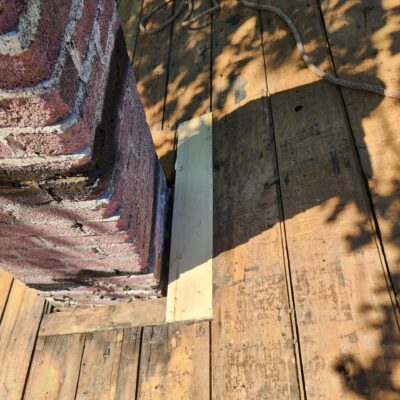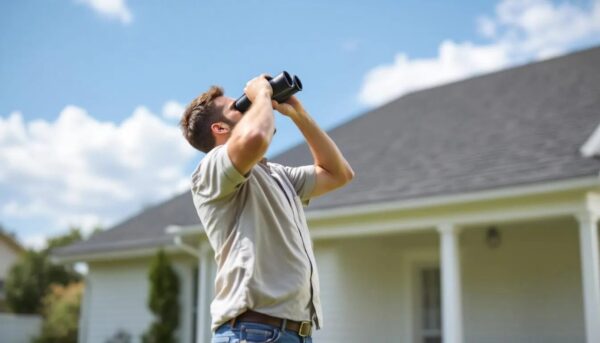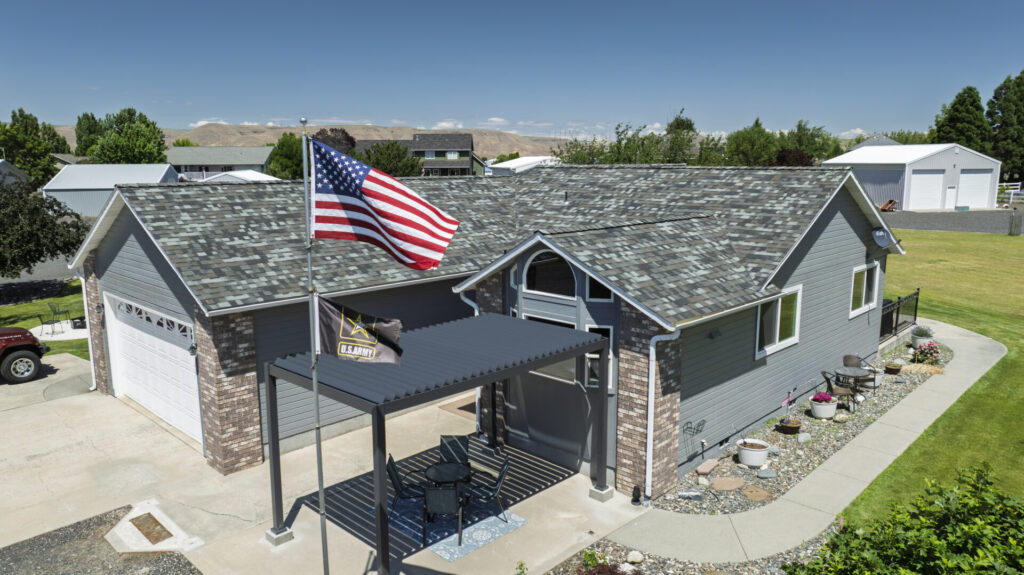Severe weather events cause billions in property damage annually, with hailstorms accounting for a significant portion of homeowners insurance claims. The National Oceanic and Atmospheric Administration recorded over 5,300 major hail events in 2024 alone, affecting millions of properties across the United States. When hail hits your roof, the damage isn’t always immediately obvious from the ground, yet even minor roof damage can lead to costly water infiltration and structural problems if left unaddressed.
Key Takeaways
- Hail damage varies significantly by roofing material – asphalt shingles show granule loss and exposed spots, while clay tiles crack or break completely
- Inspect your roof within 24-48 hours after a hailstorm to identify damage before it leads to leaks and interior damage
- Look for specific warning signs like black spots on shingles, dented gutters, and damaged roof vents or flashing
- Most homeowners insurance policies cover hail damage, but claims must be filed promptly – typically within one year of the storm
- Professional roof inspections can save thousands in undetected damage and ensure proper insurance claims
Understanding how to tell if your roof has hail damage is crucial for protecting your home and ensuring you receive proper insurance coverage. This comprehensive guide will walk you through the specific signs to look for on different roofing materials, safe inspection techniques, and the steps to take if you suspect hail damage. Whether you’re dealing with traditional asphalt shingles or metal roofing, knowing what to inspect can save you thousands in repairs and help you navigate the insurance process effectively.
Immediate Signs Your Roof Has Hail Damage
The most obvious indicators that your roof has sustained damage often appear on exterior elements you can safely observe from the ground. Start your inspection by examining gutters and downspouts for dents, particularly on the side facing the storm’s direction. Hail impacts on these metal surfaces create distinct dents that correlate directly with the size of hailstones that hit your roof.
Check outdoor air conditioning units, which are highly susceptible to hail damage and serve as excellent indicators of impact severity. If your AC unit shows significant denting, your roofing materials likely sustained damage as well. Similarly, examine damaged landscaping, dented vehicles, or broken windows – these provide clear evidence that hailstones were large enough to cause roof damage.
Interior warning signs include water stains on ceilings or walls, which may appear days or weeks after a hail storm as water infiltrates through compromised roofing material. Look for discoloration, water rings, or peeling paint that wasn’t present before the severe weather event. Generally speaking, hailstones larger than 1 inch in diameter (quarter-size) typically cause measurable damage to most roofing materials, though even smaller hail can affect vulnerable or aging roofs.
Pay attention to damaged roof accessories visible from the ground, including bent or displaced roof vents, damaged chimney caps, or compromised flashing around penetrations. These areas often show the first signs of hail impacts and can provide early indication of broader roof damage requiring professional assessment.
Hail Damage Signs by Roofing Material
 Asphalt Shingle Damage
Asphalt Shingle Damage
Asphalt shingles represent the most common roofing material in North America, and they display distinct patterns when damaged by hail impacts. The primary indicator is granule loss, which appears as dark spots where the protective granules have been knocked away, exposing the underlying asphalt matrix. These exposed areas appear as black circles or irregular patterns that differ markedly from the normal wear patterns seen with regular wear and tear.
When examining traditional asphalt shingles, look for cracks or splits with sharp, defined edges rather than the rounded edges typical of normal weathering. Fresh hail damage creates clean breaks, while aging and manufacturing defects produce more gradual deterioration. Shingles may also feel soft or spongy when pressed, indicating bruising of the underlying mat that compromises the shingle’s integrity.
Older shingles, particularly those 15 years or more, are significantly more vulnerable to hail impacts due to decreased flexibility and protective granule adhesion. The protective granules on aged shingles become brittle and detach more easily, making granule loss more pronounced after even moderate hailstorms. Check for exposed asphalt that appears as shiny black spots, which indicate areas where water can penetrate and cause long-term damage.
Wood Shingle and Shake Damage
Wood shingles and wood shakes display different damage patterns compared to asphalt materials. Hail impacts create splits with sharp edges and distinct impact marks that appear randomly across the roof surface. Unlike normal weathering, which produces predictable splitting patterns along grain lines, hail damage creates irregular fractures that may not follow the wood’s natural grain structure.
Look for brown or orange discoloration around impact marks, which indicates fresh wood exposure from recent hail hits. Moisture-saturated wood is particularly susceptible to hail damage, as wet wood fibers are more prone to splitting and fracturing under impact. The random distribution of damage distinguishes hail impacts from normal wear patterns, which typically affect shingles uniformly based on exposure and weathering. If you are experiencing significant wood shingle or shake damage, it may be time to look into a roof replacement!
Clay and Concrete Tile Damage
Clay tiles and concrete tiles are among the most durable roofing materials, but they can suffer dramatic damage from large hailstones. Unlike other roofing materials that may show subtle signs, clay tiles typically crack, chip, or break completely when struck by significant hail. Even small chips in the tile surface can lead to water infiltration and should be addressed promptly.
Walking on these roofs after storms can cause additional damage, as tiles weakened by hail impacts may break under foot traffic. Broken tiles expose the underlying roofing membrane to UV radiation and weather, accelerating deterioration of the entire roofing system. Document any visible cracks or missing tile fragments, as these represent immediate threats to your home’s weather protection.
Metal Roofing Damage
Metal roof systems generally provide excellent hail protection, with quality installations resisting hail up to 2.5 inches in diameter. However, when damage does occur, it appears as visible dents and dings on the metal surface, along with chipped or scratched paint from hail impacts. Seams and edges represent the most vulnerable areas of metal roofing systems.
While dents may appear primarily cosmetic, they can affect the roof’s drainage patterns and long-term performance. Paint damage exposes the underlying metal to corrosion, particularly in coastal or industrial environments. Document all visible dents and paint damage, as many insurance policies cover cosmetic damage to metal roofing when caused by covered perils like hailstorms.
When and How to Conduct Your Inspection

Timing your roof inspection correctly is crucial for accurate damage assessment and insurance claim success. Inspect your roof within 24-48 hours after a hailstorm when it’s safe to do so, as this timeframe allows you to identify damage before additional weather can worsen existing problems or make it difficult to attribute damage to the specific storm event.
Conduct your initial inspection from ground level using binoculars to examine accessible roof areas safely. Focus on gutters, downspouts, and roof accessories first, as these provide clear indicators of impact severity without requiring you to climb onto potentially damaged roofing materials. Look for dents in gutters, damaged vent covers, and displaced or bent flashing around chimneys and roof penetrations.
Seasonal timing affects inspection strategies significantly. Spring inspections are particularly important as they catch winter storm damage before summer heat and UV exposure worsen any compromised materials. Fall inspections prepare your roof for winter weather by identifying and repairing damage before freeze-thaw cycles can expand cracks or allow water infiltration.
Never attempt to walk on your roof immediately after a hail storm, as damaged materials may not support your weight safely. Additionally, wet conditions following storms create serious slip hazards even on undamaged roofs. If you must access the roof for emergency repairs, use proper safety equipment and consider hiring professionals who carry appropriate insurance coverage.
Professional vs. DIY Inspection
Professional roof inspections are considered a relatively small investment compared to the potential costs of missed damage. Professional inspectors provide comprehensive documentation including detailed photographs, measurements of impact marks, and formal reports that insurance companies readily accept for claim processing.
While homeowners can identify obvious damage from ground level, professionals have the training, equipment, and insurance coverage necessary to safely access all roof areas. They understand how to distinguish between hail damage and other issues like manufacturing defects, normal wear and tear, or previous storm damage. This expertise proves invaluable when dealing with insurance adjusters who scrutinize claims carefully.
Some contractors offer free inspections, but be aware of potential conflicts of interest. Storm chasers and unscrupulous contractors may exaggerate damage to secure repair contracts. Choose reputable, local contractors, like our team at Russell Quality Roofing who provide detailed written assessments and don’t pressure you into immediate repair decisions. Verify licensing, insurance coverage, and local references before allowing anyone to inspect your roof.
Professional inspections become essential after severe weather events or when you spot any potential damage indicators. The cost of a professional assessment pales in comparison to the thousands of dollars in repairs that undetected damage can cause over time through water infiltration and structural deterioration.
What to Do If You Find Hail Damage
When you identify potential hail damage, prioritize safety and damage documentation immediately. Start with a safety assessment – if you notice any structural damage, water intrusion, or compromised roofing materials, contact emergency services and avoid affected areas until professional assessment confirms safety.
Document all damage thoroughly with photographs taken from multiple angles, including close-up shots of specific impact marks and wider shots showing the overall affected areas. Include date stamps on photos and take images that show the damage in relation to identifiable landmarks or reference points. This documentation proves crucial for insurance claims and contractor estimates.
Contact your insurance company promptly to report the damage and initiate the claims process. Most policies require reporting storm damage within one year of the event, but earlier reporting typically results in faster claim processing and resolution. Provide your insurer with initial damage documentation and request guidance on approved contractors and repair procedures.
Implement temporary emergency repairs only if necessary to prevent further damage, such as covering exposed areas with tarps during continuing storms. Document these temporary measures with photographs and save receipts, as many insurance policies reimburse reasonable emergency protection costs. Avoid permanent repairs until your insurance adjuster completes their assessment, as premature repairs can complicate claim processing.
When selecting contractors, avoid storm chasers who go door-to-door immediately after hailstorms. Choose licensed, insured, local contractors with established reputations and verifiable references. Obtain multiple written estimates and ensure any contractor you hire coordinates directly with your insurance adjuster throughout the repair process.

Contact Russell Quality Roofing to Help with Repairing Hail Damage
If you suspect your home may have sustained hail damage, don’t wait until a small issue turns into a costly roof replacement. Contact Russell Quality Roofing today for a professional hail damage inspection. Our certified roofing specialists will perform a thorough assessment of your roof system, document all visible and hidden storm damage, and provide you with a detailed inspection report you can use when working with your homeowners insurance company.
As a trusted local roofing contractor, we assist homeowners across Idaho and Washington in identifying and repairing storm-related damage quickly and accurately. Whether you need emergency repairs, a full roof replacement, or help navigating an insurance claim, our team is here to guide you every step of the way. Protect your investment, maintain your coverage, and ensure lasting performance from your roof—schedule your free roof inspection with Russell Quality Roofing today.
FAQs
How long after a hailstorm should I inspect my roof?
You should inspect your roof within 24-48 hours after a hailstorm when it’s safe to do so. This timeframe allows you to identify damage before additional weather can worsen existing problems. However, prioritize safety – wait until winds subside and avoid inspecting during ongoing severe weather. Document the date of your inspection as this information proves important for insurance claims and establishing when damage occurred.
Can small hail (pea-sized) actually damage my roof?
Small hail typically doesn’t cause significant damage to most roofing materials, but it can affect older or already compromised roofs. Hailstones need to be at least 1 inch in diameter (quarter-size) to commonly cause damage to standard asphalt shingles. However, if small hail is accompanied by high winds (60+ mph), it can cause more damage than size alone would suggest. The age and condition of your roofing material also affects vulnerability to smaller hailstones.
Is it safe to walk on my roof to check for hail damage?
It’s generally not recommended to walk on your roof after a hailstorm. Hail damage can weaken roofing materials, making them more likely to break under your weight. Additionally, wet conditions after storms create slip hazards. Use binoculars from the ground level or hire a professional inspector who has proper safety equipment and insurance. If emergency access is absolutely necessary, use proper safety harnesses and consider the liability implications.
Will my insurance cover cosmetic hail damage that doesn’t affect function?
Insurance coverage for cosmetic hail damage varies by policy and state regulations. Many standard policies cover functional damage but may exclude purely cosmetic issues. Review your specific policy language or consult with your insurance agent to understand your coverage limits. Metal roofing cosmetic damage is often covered when caused by covered perils.
How can I tell the difference between hail damage and normal roof wear?
Hail damage typically appears as random patterns across the roof with sharp, defined edges on breaks or cracks. Normal wear shows gradual deterioration in predictable patterns – like granule loss along shingle edges or consistent fading from UV exposure. Hail damage often creates circular impact marks or defined punctures, while aging creates more uniform deterioration. Fresh hail damage exposes bright, clean material underneath, whereas normal wear appears weathered and gradual. When in doubt, hire a professional inspector who can definitively distinguish between storm damage and normal wear and tear.
AWARD WINNING PRODUCE
Order Online
Lorem ipsum dolor sit amet, consectetur adipiscing elit. Pellentesque vestibulum aliquam cursus. Mauris molestie aliquam urna. Curabitur nec eleifend risus. Integer eget libero sed elit pharetra ultricies eu in augue. Integer eget libero sed elit pharetra ultricies eu in augue.
BROWSE OUR ITEMS
